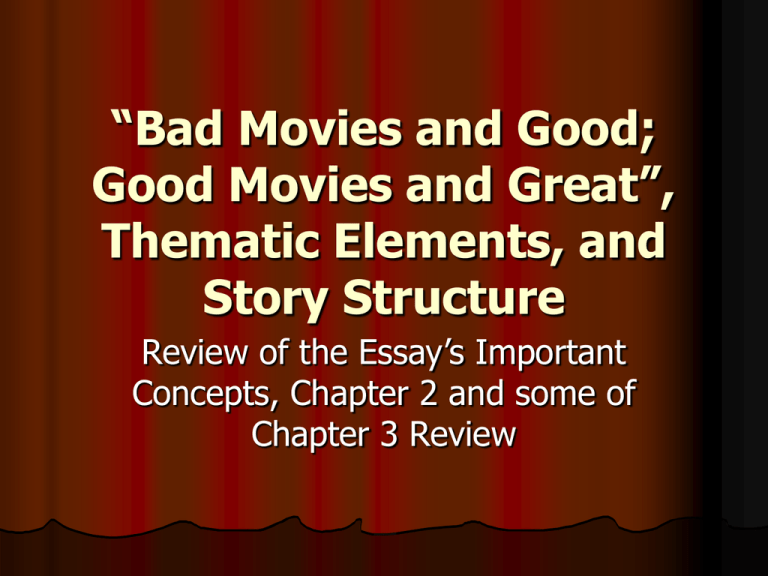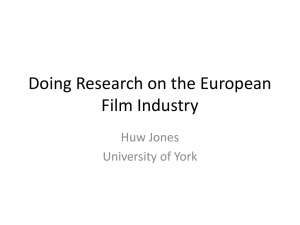Perrine Article and Chapter 2 (Theme)
advertisement

“Bad Movies and Good; Good Movies and Great”, Thematic Elements, and Story Structure Review of the Essay’s Important Concepts, Chapter 2 and some of Chapter 3 Review In judging a film, we need to ask three basic questions: What is its central purpose? (theme) How fully has this purpose been accomplished? 3. How important is this purpose? 1. 2. Purpose of First Question: Understand the film Purpose of Second Question: Measure its perfection Purpose of Third Question: Measure its significance Chapter 2: Thematic Elements Theme: The central, unifying purpose and focus of the film (Unlike literature, the theme of the film is not limited to an idea.) Types of Themes found in Film: 1. Plot 2. Emotional Effect or Mood 3. Character 4. Style, Texture, Structure 5. Idea Focus on Plot The film is most concerned with what happens. Its primary purpose/ focus is linked to its plot. Action/Adventure films and detective stories are concerned mainly with plot Examples: Bourne Series, Gladiator, Day After Tomorrow, LA Confidential , Raiders of the Lost Ark, Pirates of the Caribbean Emotional Effect or Mood The film’s primary concern is to convey a certain mood to an audience, get the audience to feel and react a certain way. Horror/Suspense Films are most notably concerned with the Emotional Effect Horror/Suspense: Alfred Hitchcok films, Saw Series, Texas Chainsaw Massacre series Comedy: Stepbrothers, Superbad Romantic Films: Notebook Dramadies (part comedy and part drama) are concerned with both emotions. Royal Tenenbaums Character The film’s primary concern is with portraying a unique character and tracing his/her development. These films are “character driven” rather than plot driven. Bio-pictures focus on character (Ali, Raging Bull, Frida, Ray, Capote) Non-bio pictures that also focus on portraying a unique character: Rushmore, Charlie Bartlett, Napoleon Dynamite Texture, Style, Structure These films are most concerned with the visual representation of the story and experimenting with style and structure. What we remember most is the “look” of the film or the way in which the story was told. Examples: Memento, Sin City, New World, Waking Life, 300, Scanner Darkly Ideas The film’s primary concern is to convey an idea about life, human relationships, the human experience, and/or society. The idea may be stated directly by a character or clearly represented by a particular scene or conveyed more subtlety through the connection of various elements. The film’s central idea is open for interpretation and there may be several opinions as to what a film’s central idea is. Perfect Film no excess scenes, no shot that does not contribute to the total meaning no cinematic element—cinematography, acting, dialogue, editing, sound—that distracts from the central purpose of the film. Each cinematic element will be the best possible one for expressing the total meaning: The images and the dialogue will be fresh, not trite (except, of course, when the film deliberately uses trite or clichéd cinematic language for purposes of irony). Perfect Film, cont. There will be no clashes between the scenes and sound of the film and its sense, or its form and its content. The structure of the film will be the best possible structure: images and sound will be so effectively arranged that any rearrangement would be harmful to the film. Elements of a Good Story Unified in plot Credible Interesting Simple and Complex Handles emotional Material with Restraint (Chapter 3 Review) Good vs. Great Film A great film communicates a richer experience; it successfully accomplishes a more significant purpose. The discriminating viewer will get from it a deeper enjoyment because he has been nourished as well as delighted. Great movies engage the whole viewer in his response— senses, imagination, emotion, intellect; it does not touch the viewer on just one or two sides of his nature. Great films seek not merely to entertain the viewer but to bring the audience, along with pure pleasure, fresh insights, or renewed insights, and important insights, into the nature of human experience. Good Vs. Great Film (cont.) Great film, we might say, gives its viewer a broader and deeper understanding of life, of his fellow men and of himself, always with the qualification, of course, that the kind of insight which art gives is not necessarily the kind that can be summed up in a simple “lesson” or “moral.” It is knowledge--felt knowledge, new knowledge--of the complexities of human nature and of the tragedies and sufferings, the excitements and joys, that characterize human experience







